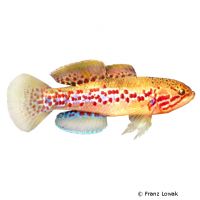Purple Sleeper Goby (Mogurnda mogurnda)
| Purple Sleeper Goby Mogurnda mogurnda | |
|---|---|
| Name | Purple Sleeper Goby |
| Name Lat. | Mogurnda mogurnda |
| Family | Bully Sleepers |
| Family lat. | Eleotridae |
| Order | Gobies |
| Order lat. | Gobiiformes |
| Origin | Australia |
| Habitat | Forest streams, ponds |
| Diet | Carnivore |
| pH | 6.0-8.0 |
| Behavior | Semi-aggressive |
| Keeping | Harem, group |
| Care Level | Easy |
| Reproduction | Substrate spawner |
| Breeding | Moderately difficult |
| Life Span | 3-5 years |
| Protection | No |
| Metric Units | |
| Size | 10 cm |
| Temperature | 24-26 °C |
| Hardness | 10-20 °dH |
| Aquarium | 150 l |
| US Units | |
| Size | 3.9" |
| Temperature | 75-79 °F |
| Hardness | 178-356 ppm |
| Aquarium | 40 gal |
Distribution and habitat
The distribution area of the spotted goby is northern Australia and southern New Guinea. They live in very different habitats, such as slow-flowing forest streams, ponds and swamps with dense underwater vegetation, roots and stones....
Maintenance
The aquarium should have dense planting, with numerous hiding places (roots, stones, caves) and sufficient swimming space. A fine-grained substrate covered with some foliage (e.g. sea almond tree), shaded light (floating plants) and medium-hard to hard water without current is ideal.
No ammonia, ammonium and nitrite should be detectable, the nitrate value should not exceed 100 mg/l. To ensure the water quality and oxygen content, a filter and heater adapted to the aquarium size is required, as well as lighting for the species-appropriate day-night rhythm of the animals.
Diet
The food supply consists of live or frozen cyclops, daphnia, bosmids, artemia, mosquito larvae, etc. or a commercially available, frozen special food mix. Dry food (granules, flakes) is also usually well accepted, but should not be the main component of the diet.
A regular and varied diet promotes health and prevents deficiency symptoms. Only as much should be fed as is eaten immediately (in a maximum of 10 minutes).
Behaviour and compatibility
They should be kept in a harem, one male with several females or in a group of 6-8 animals. Males are somewhat territorial within the species. A socialization with other fish, like robust tetras, barbs or rainbowfish is well possible. Only with long-finned fish caution is advised, as they tend to fin plucking.
Basically, only compatible fish species with similar demands on water condition and water temperature should be socialized.
Sex dimorphism
The sexes are difficult to distinguish. The males are slightly smaller than the females. With some experience, adolescent animals can be distinguished by their genital papilla, which is pointed in the male.
Reproduction and breeding
They are substrate spawners. The female lays her eggs, 20-200 pieces on a plant, root or stone, often also on the aquarium glass. After egg laying, the male drives the female away and takes over brood care. It fans and protects the spawn. The larvae hatch after 5-10 days and as soon as the fry swim free the brood care ends.
Fry must be fed several times a day with special rearing food (Artemia nauplii). In community tanks breeding is hardly possible, because the fry are easy prey.
Important
These gobies do not require water treated with salt.
They show their most beautiful coloration by feeding with live food.
The well-being of the fish should be checked regularly. Temperature should be checked daily, pH, hardness and nitrate levels at least every 14 days. Regular partial water changes are recommended, even if the contaminant level has not yet reached the upper limit. Sudden changes in water quality should be avoided. Newly introduced fish must be accustomed slowly to the water in the aquarium.
Further literature can be found in your pet store.
References
Text: Werner Winter; Image: Franz Lowak
Source: BMELV (1998): Tierschutzgutachten - Haltung von Zierfischen (Süßwasser); BAENSCH & RIEHL (2004): Aquarien Atlas Bd. 2, Mergus Verlag; ENGELMANN (2005): Zootierhaltung - Tiere in menschlicher Obhut: Fische, Verlag Harri Deutsch
- Gemäß § 21 Abs. 5 Tierschutzgesetz idgF
